Business Economics Assignment - University Name, Semester 1, 2024
VerifiedAdded on 2020/04/13
|7
|871
|227
Homework Assignment
AI Summary
This business economics assignment explores two key areas: price elasticity of demand and international trade theories. The first part defines price elasticity, discusses its importance in firm decision-making, and examines price discrimination. The second part analyzes the theories of absolute and comparative advantage in international trade, highlighting their implications and limitations, including instances where countries don't fully utilize these advantages. The assignment covers the concepts, provides analysis, and draws conclusions based on economic principles and theories. It provides a comprehensive overview of elasticity and trade, making it a valuable resource for students studying business economics. References are included to support the analysis.
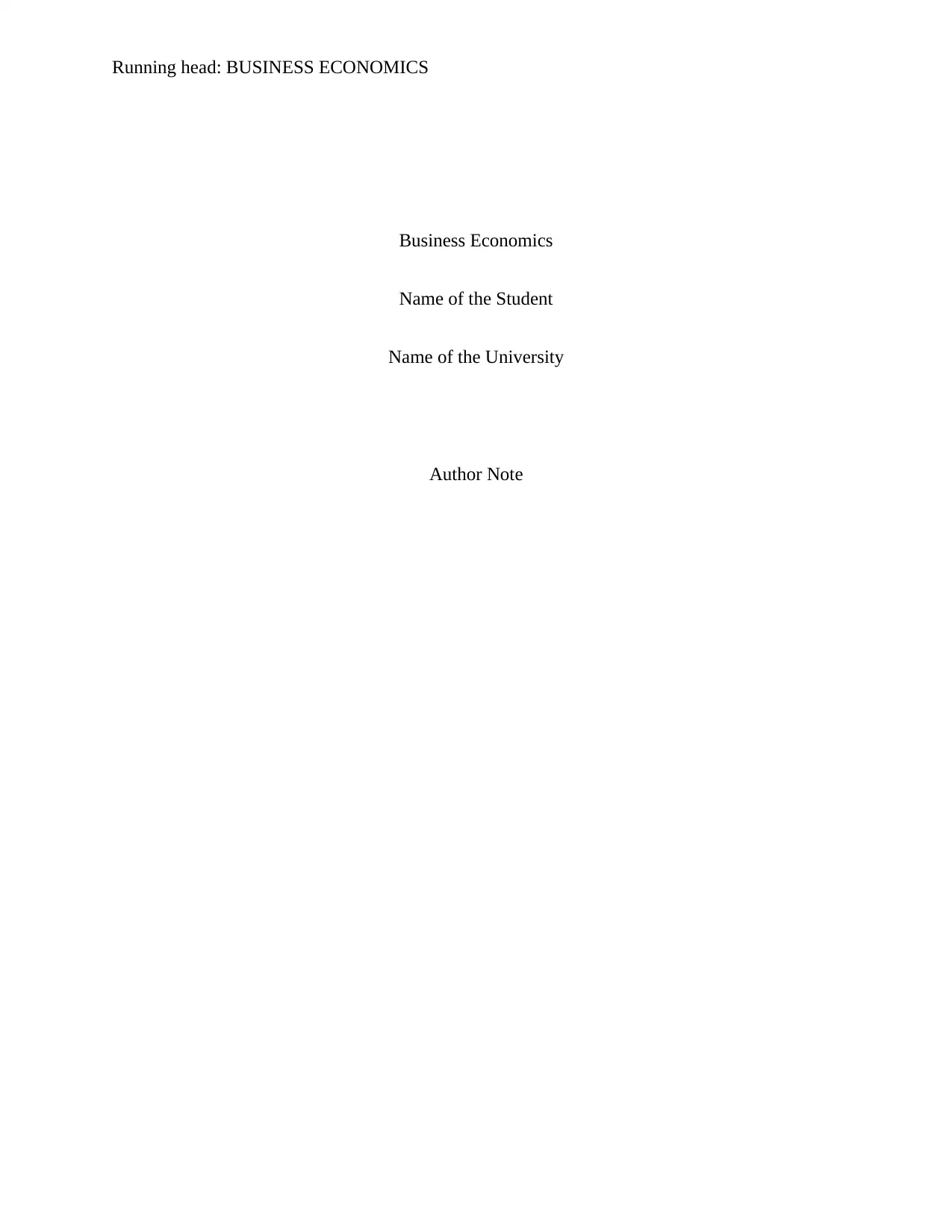
Running head: BUSINESS ECONOMICS
Business Economics
Name of the Student
Name of the University
Author Note
Business Economics
Name of the Student
Name of the University
Author Note
Paraphrase This Document
Need a fresh take? Get an instant paraphrase of this document with our AI Paraphraser
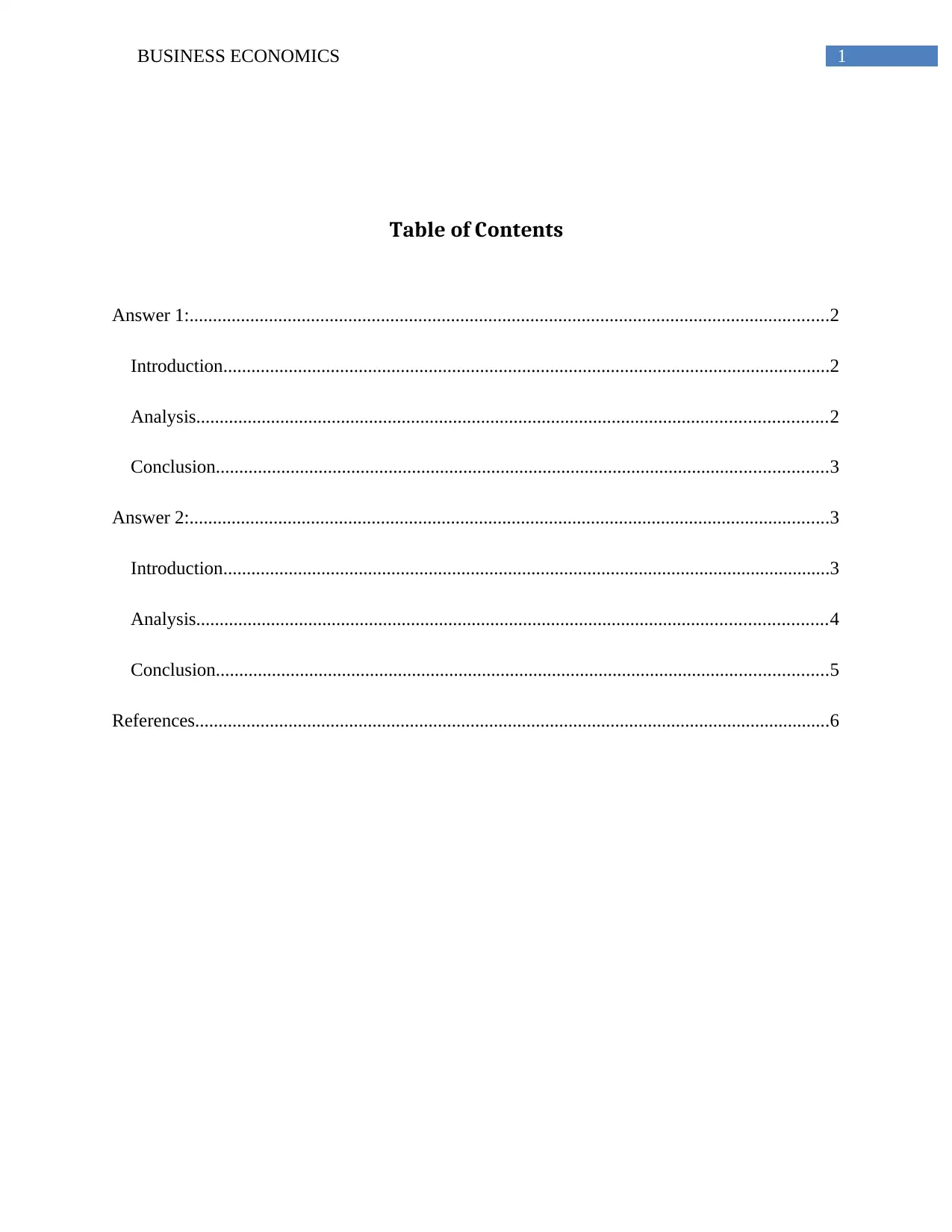
1BUSINESS ECONOMICS
Table of Contents
Answer 1:.........................................................................................................................................2
Introduction..................................................................................................................................2
Analysis.......................................................................................................................................2
Conclusion...................................................................................................................................3
Answer 2:.........................................................................................................................................3
Introduction..................................................................................................................................3
Analysis.......................................................................................................................................4
Conclusion...................................................................................................................................5
References........................................................................................................................................6
Table of Contents
Answer 1:.........................................................................................................................................2
Introduction..................................................................................................................................2
Analysis.......................................................................................................................................2
Conclusion...................................................................................................................................3
Answer 2:.........................................................................................................................................3
Introduction..................................................................................................................................3
Analysis.......................................................................................................................................4
Conclusion...................................................................................................................................5
References........................................................................................................................................6
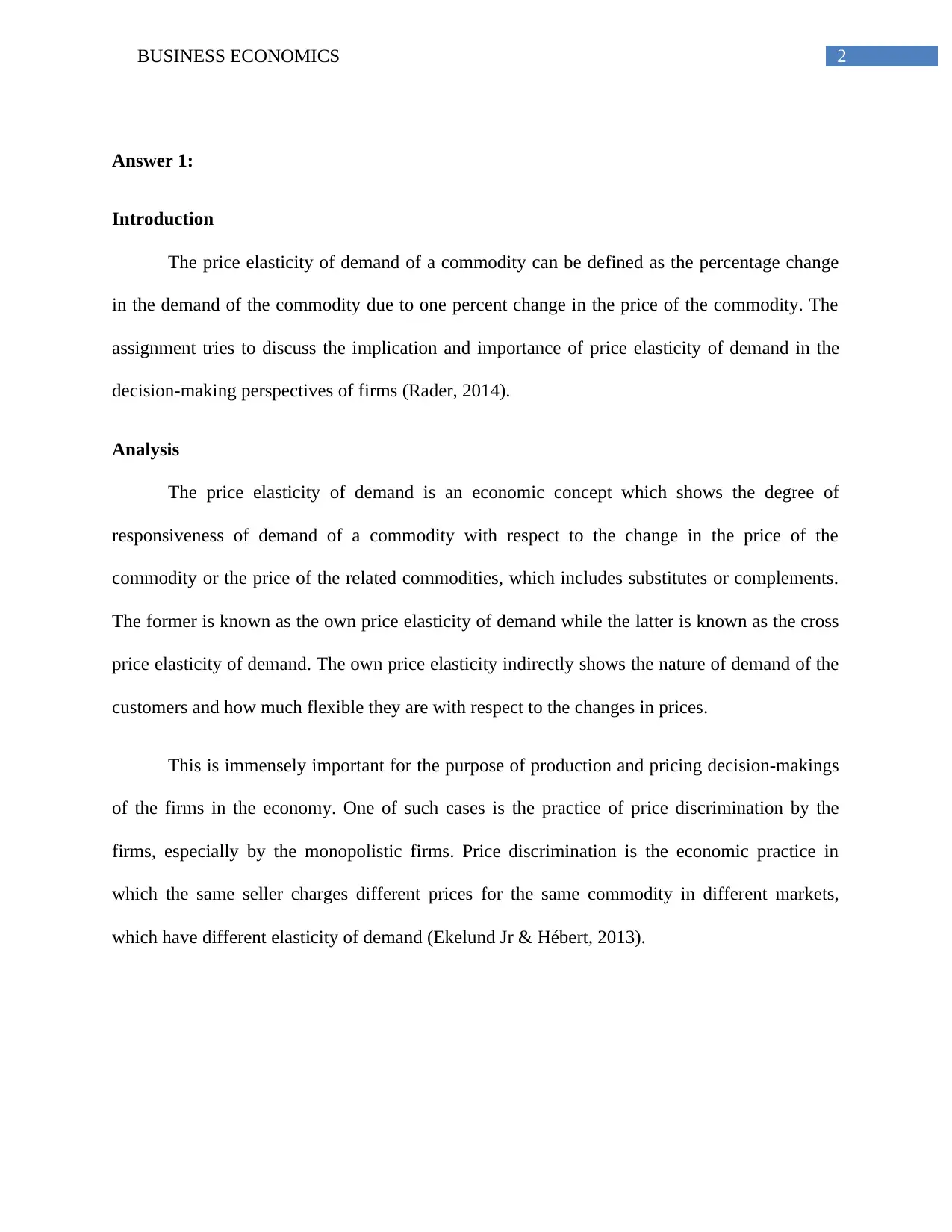
2BUSINESS ECONOMICS
Answer 1:
Introduction
The price elasticity of demand of a commodity can be defined as the percentage change
in the demand of the commodity due to one percent change in the price of the commodity. The
assignment tries to discuss the implication and importance of price elasticity of demand in the
decision-making perspectives of firms (Rader, 2014).
Analysis
The price elasticity of demand is an economic concept which shows the degree of
responsiveness of demand of a commodity with respect to the change in the price of the
commodity or the price of the related commodities, which includes substitutes or complements.
The former is known as the own price elasticity of demand while the latter is known as the cross
price elasticity of demand. The own price elasticity indirectly shows the nature of demand of the
customers and how much flexible they are with respect to the changes in prices.
This is immensely important for the purpose of production and pricing decision-makings
of the firms in the economy. One of such cases is the practice of price discrimination by the
firms, especially by the monopolistic firms. Price discrimination is the economic practice in
which the same seller charges different prices for the same commodity in different markets,
which have different elasticity of demand (Ekelund Jr & Hébert, 2013).
Answer 1:
Introduction
The price elasticity of demand of a commodity can be defined as the percentage change
in the demand of the commodity due to one percent change in the price of the commodity. The
assignment tries to discuss the implication and importance of price elasticity of demand in the
decision-making perspectives of firms (Rader, 2014).
Analysis
The price elasticity of demand is an economic concept which shows the degree of
responsiveness of demand of a commodity with respect to the change in the price of the
commodity or the price of the related commodities, which includes substitutes or complements.
The former is known as the own price elasticity of demand while the latter is known as the cross
price elasticity of demand. The own price elasticity indirectly shows the nature of demand of the
customers and how much flexible they are with respect to the changes in prices.
This is immensely important for the purpose of production and pricing decision-makings
of the firms in the economy. One of such cases is the practice of price discrimination by the
firms, especially by the monopolistic firms. Price discrimination is the economic practice in
which the same seller charges different prices for the same commodity in different markets,
which have different elasticity of demand (Ekelund Jr & Hébert, 2013).
⊘ This is a preview!⊘
Do you want full access?
Subscribe today to unlock all pages.

Trusted by 1+ million students worldwide
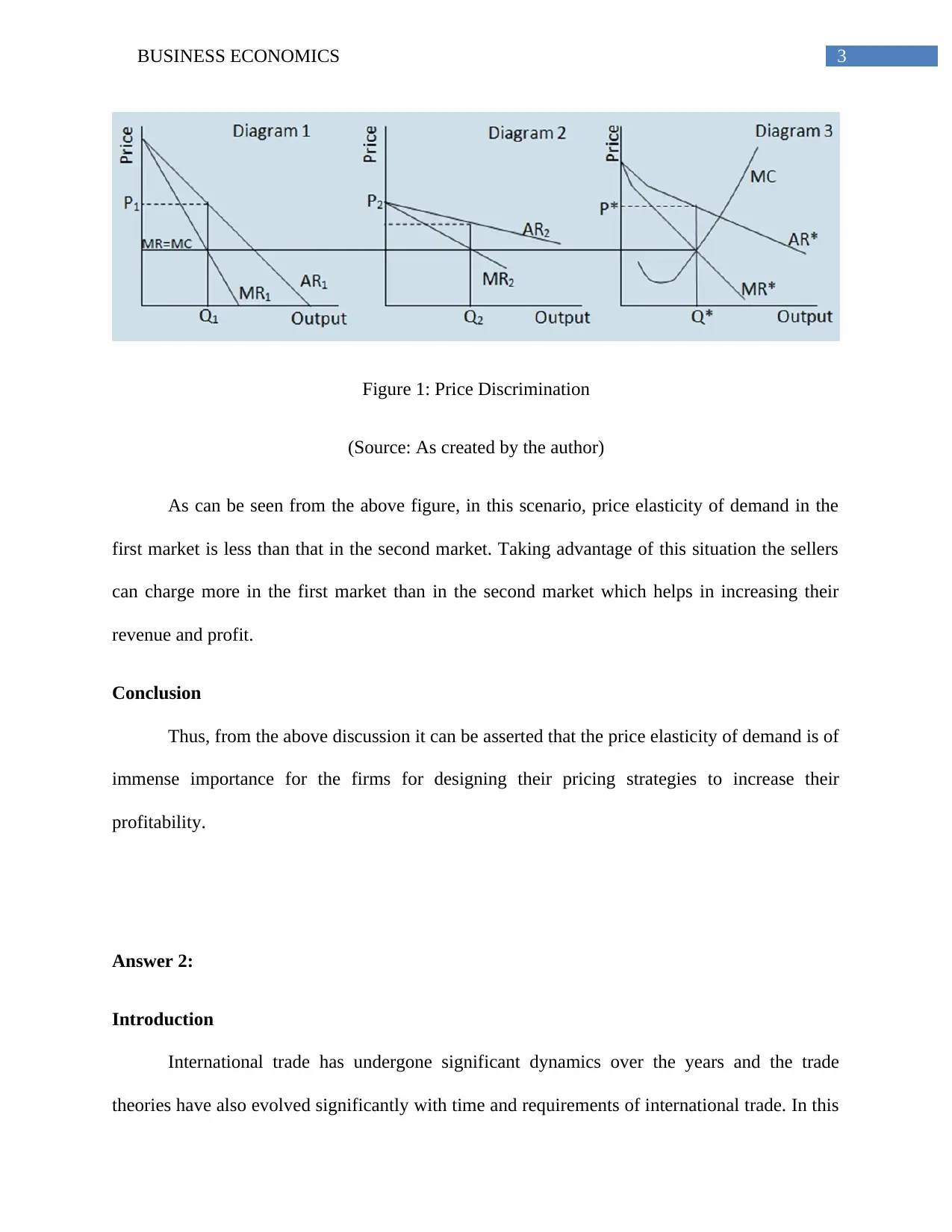
3BUSINESS ECONOMICS
Figure 1: Price Discrimination
(Source: As created by the author)
As can be seen from the above figure, in this scenario, price elasticity of demand in the
first market is less than that in the second market. Taking advantage of this situation the sellers
can charge more in the first market than in the second market which helps in increasing their
revenue and profit.
Conclusion
Thus, from the above discussion it can be asserted that the price elasticity of demand is of
immense importance for the firms for designing their pricing strategies to increase their
profitability.
Answer 2:
Introduction
International trade has undergone significant dynamics over the years and the trade
theories have also evolved significantly with time and requirements of international trade. In this
Figure 1: Price Discrimination
(Source: As created by the author)
As can be seen from the above figure, in this scenario, price elasticity of demand in the
first market is less than that in the second market. Taking advantage of this situation the sellers
can charge more in the first market than in the second market which helps in increasing their
revenue and profit.
Conclusion
Thus, from the above discussion it can be asserted that the price elasticity of demand is of
immense importance for the firms for designing their pricing strategies to increase their
profitability.
Answer 2:
Introduction
International trade has undergone significant dynamics over the years and the trade
theories have also evolved significantly with time and requirements of international trade. In this
Paraphrase This Document
Need a fresh take? Get an instant paraphrase of this document with our AI Paraphraser
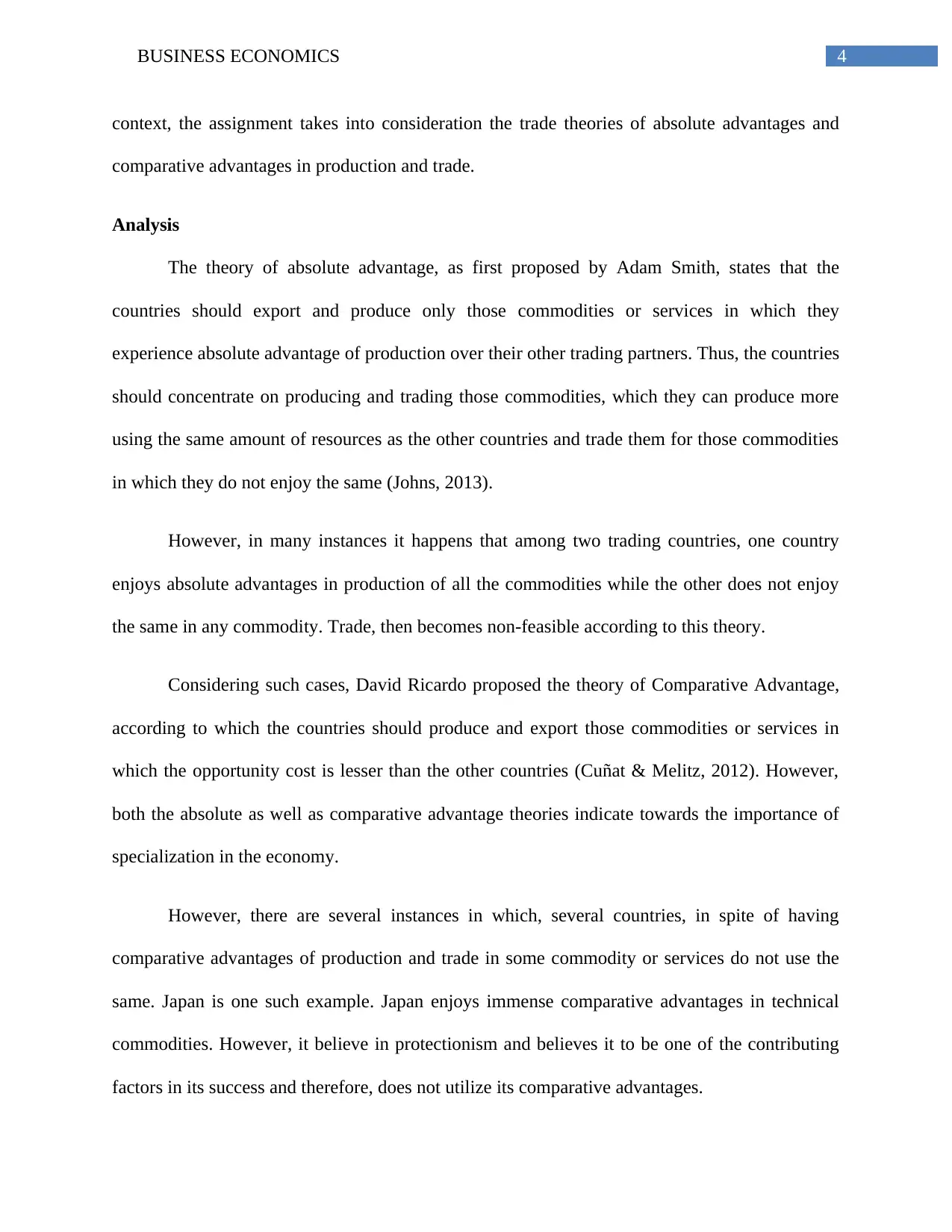
4BUSINESS ECONOMICS
context, the assignment takes into consideration the trade theories of absolute advantages and
comparative advantages in production and trade.
Analysis
The theory of absolute advantage, as first proposed by Adam Smith, states that the
countries should export and produce only those commodities or services in which they
experience absolute advantage of production over their other trading partners. Thus, the countries
should concentrate on producing and trading those commodities, which they can produce more
using the same amount of resources as the other countries and trade them for those commodities
in which they do not enjoy the same (Johns, 2013).
However, in many instances it happens that among two trading countries, one country
enjoys absolute advantages in production of all the commodities while the other does not enjoy
the same in any commodity. Trade, then becomes non-feasible according to this theory.
Considering such cases, David Ricardo proposed the theory of Comparative Advantage,
according to which the countries should produce and export those commodities or services in
which the opportunity cost is lesser than the other countries (Cuñat & Melitz, 2012). However,
both the absolute as well as comparative advantage theories indicate towards the importance of
specialization in the economy.
However, there are several instances in which, several countries, in spite of having
comparative advantages of production and trade in some commodity or services do not use the
same. Japan is one such example. Japan enjoys immense comparative advantages in technical
commodities. However, it believe in protectionism and believes it to be one of the contributing
factors in its success and therefore, does not utilize its comparative advantages.
context, the assignment takes into consideration the trade theories of absolute advantages and
comparative advantages in production and trade.
Analysis
The theory of absolute advantage, as first proposed by Adam Smith, states that the
countries should export and produce only those commodities or services in which they
experience absolute advantage of production over their other trading partners. Thus, the countries
should concentrate on producing and trading those commodities, which they can produce more
using the same amount of resources as the other countries and trade them for those commodities
in which they do not enjoy the same (Johns, 2013).
However, in many instances it happens that among two trading countries, one country
enjoys absolute advantages in production of all the commodities while the other does not enjoy
the same in any commodity. Trade, then becomes non-feasible according to this theory.
Considering such cases, David Ricardo proposed the theory of Comparative Advantage,
according to which the countries should produce and export those commodities or services in
which the opportunity cost is lesser than the other countries (Cuñat & Melitz, 2012). However,
both the absolute as well as comparative advantage theories indicate towards the importance of
specialization in the economy.
However, there are several instances in which, several countries, in spite of having
comparative advantages of production and trade in some commodity or services do not use the
same. Japan is one such example. Japan enjoys immense comparative advantages in technical
commodities. However, it believe in protectionism and believes it to be one of the contributing
factors in its success and therefore, does not utilize its comparative advantages.
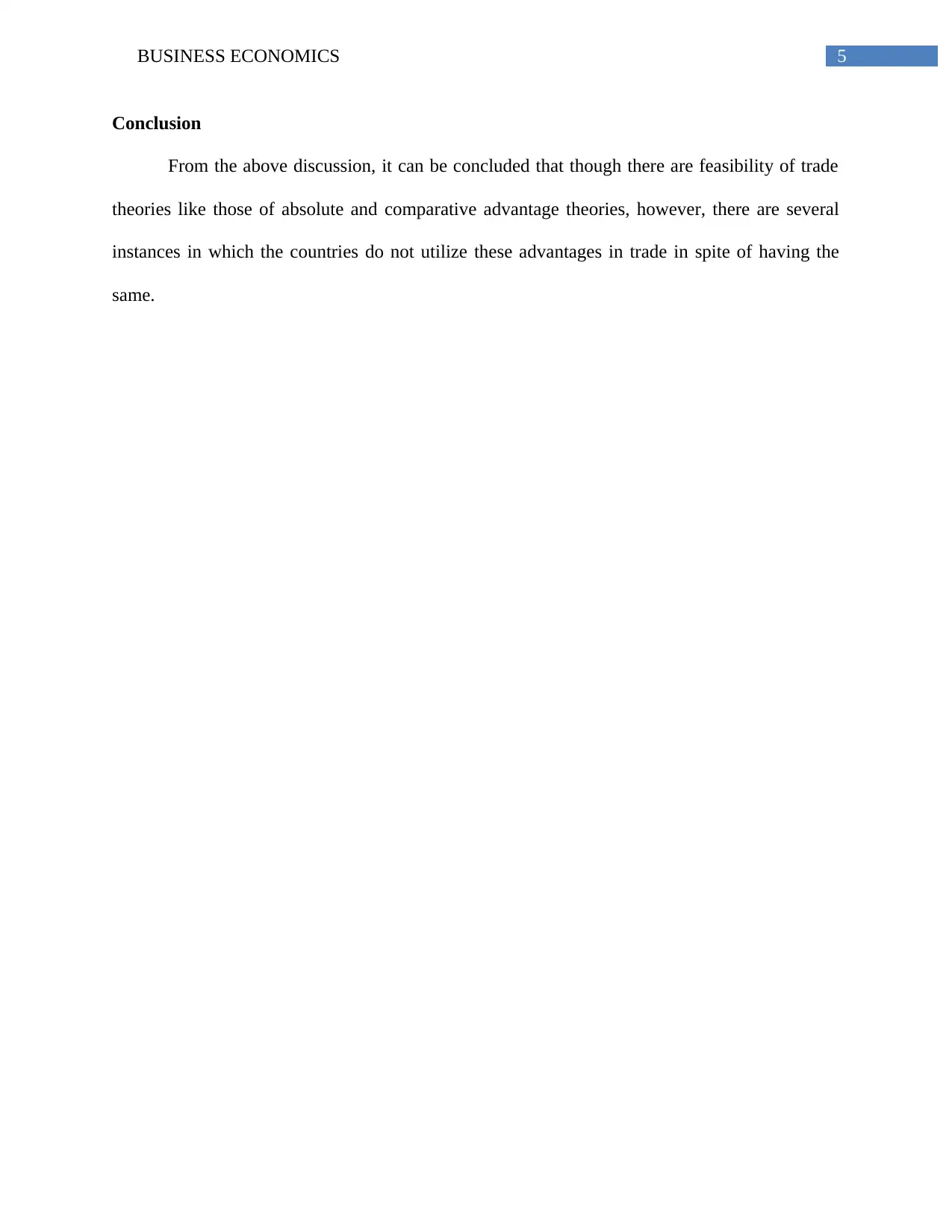
5BUSINESS ECONOMICS
Conclusion
From the above discussion, it can be concluded that though there are feasibility of trade
theories like those of absolute and comparative advantage theories, however, there are several
instances in which the countries do not utilize these advantages in trade in spite of having the
same.
Conclusion
From the above discussion, it can be concluded that though there are feasibility of trade
theories like those of absolute and comparative advantage theories, however, there are several
instances in which the countries do not utilize these advantages in trade in spite of having the
same.
⊘ This is a preview!⊘
Do you want full access?
Subscribe today to unlock all pages.

Trusted by 1+ million students worldwide
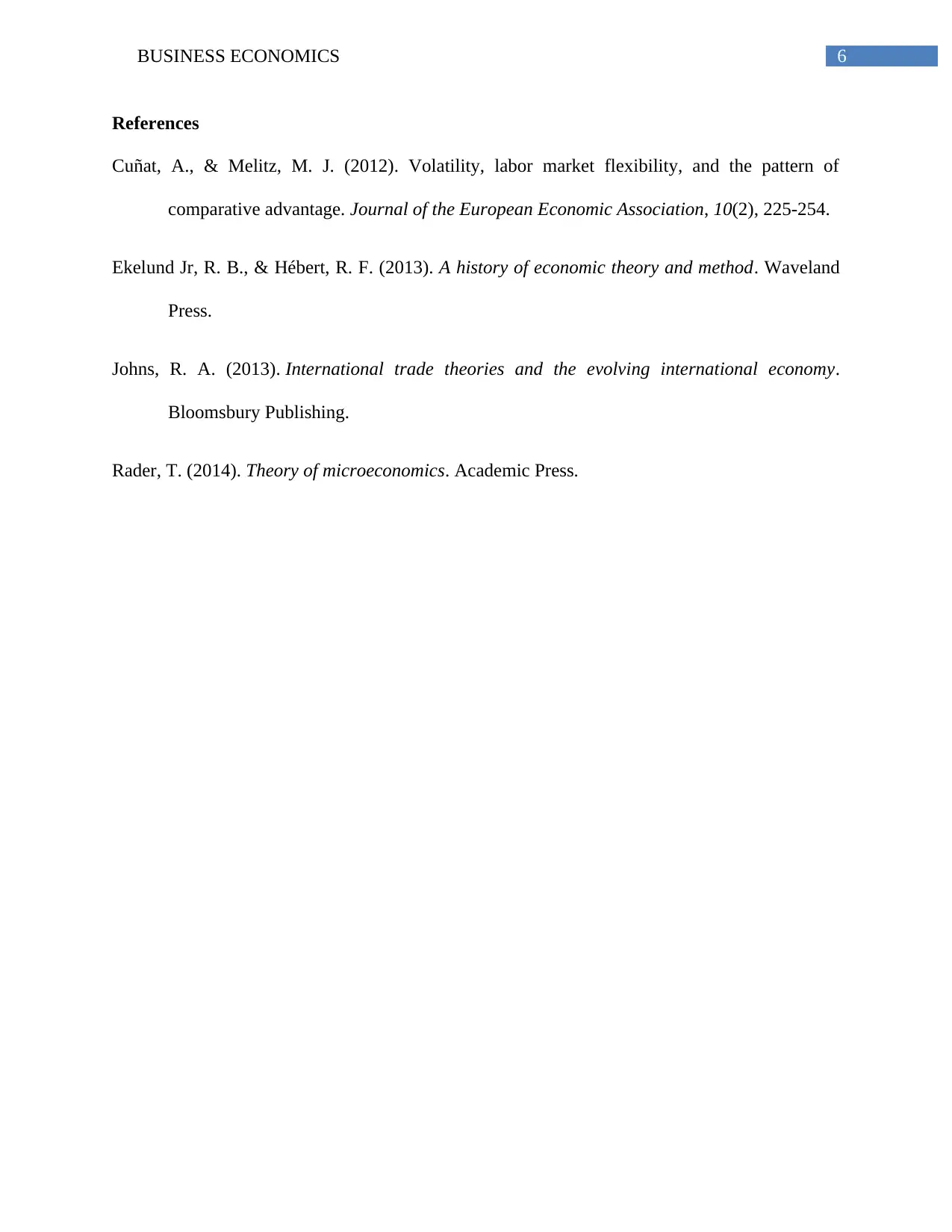
6BUSINESS ECONOMICS
References
Cuñat, A., & Melitz, M. J. (2012). Volatility, labor market flexibility, and the pattern of
comparative advantage. Journal of the European Economic Association, 10(2), 225-254.
Ekelund Jr, R. B., & Hébert, R. F. (2013). A history of economic theory and method. Waveland
Press.
Johns, R. A. (2013). International trade theories and the evolving international economy.
Bloomsbury Publishing.
Rader, T. (2014). Theory of microeconomics. Academic Press.
References
Cuñat, A., & Melitz, M. J. (2012). Volatility, labor market flexibility, and the pattern of
comparative advantage. Journal of the European Economic Association, 10(2), 225-254.
Ekelund Jr, R. B., & Hébert, R. F. (2013). A history of economic theory and method. Waveland
Press.
Johns, R. A. (2013). International trade theories and the evolving international economy.
Bloomsbury Publishing.
Rader, T. (2014). Theory of microeconomics. Academic Press.
1 out of 7
Related Documents
Your All-in-One AI-Powered Toolkit for Academic Success.
+13062052269
info@desklib.com
Available 24*7 on WhatsApp / Email
![[object Object]](/_next/static/media/star-bottom.7253800d.svg)
Unlock your academic potential
Copyright © 2020–2025 A2Z Services. All Rights Reserved. Developed and managed by ZUCOL.





